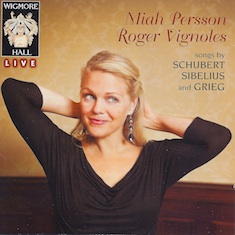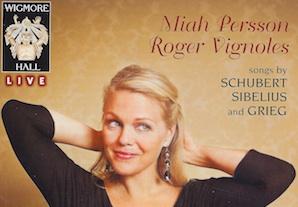
There comes a time in the career of many a sweet-voiced lyric soprano when the bloom of youth melds with the emotional depth of maturity. For Miah Persson, that time came on February 16, 2011, when, three months shy of her 40th birthday, she joined the superb pianist Roger Vignoles in London’s Wigmore Hall for a recital of songs by Schubert, Grieg, and Sibelius. Much of Persson’s singing that evening was so beautiful, and so filled with feeling, as to make the recital CD essential for all lovers of the soprano voice.
Persson’s gifts are apparent in the very first of her 20 songs, Schubert’s “Suleika I.” “Was bedeutet die Bewegnung?” (What does this stirring mean?), she asks with total involvement, as Vignoles creates the motion of wind, wings, and a heart all a-flutter. She continues, “Does the East Wind bring good tidings? … Its soft murmur brings me a thousand greetings from my friend.” As the song is spun out, the image of a soprano in formal dress, standing in the curve of a grand piano, fades before the palpable reality of an open-hearted woman seized by love. Schubert’s song may have been written 190 ago, but Persson’s feeling is now.
Listen To The Music
Suleika I, D720Six Songs, Op. 48: Dereinst, Gedanke Mein


In song after song, Persson impresses with her vocal beauty and her depth of feeling. Although the microphone can’t fully capture all her lustrous overtones — there’s some distortion that’s not of her own making as the voice rises into the head — she conveys her emotions without blemish. In her Schubert set, she grows extremely impassioned in Mignon’s song, “Nur wer die Sehnsucht kent” (Only those who know longing), and conveys the peace and faith of his great song “Du bist die Ruh” (You are repose). Then, in Grieg’s “Dereinst, Gedanke mein” (One day, my thoughts, you shall be at rest), she sings as if in prayer, with such sincerity as to melt the hardest heart.
Although the microphone also shortchanges the richness of Vignoles’ instrument, his ability to capture a song’s every mood without grandstanding consistently furthers Persson’s intentions. His joy at the start of Grieg’s “Gruß” (Greeting) is as irresistible as his suitably watery accompaniment in Sibelius’ “Var det en dröm?” (Did I just dream?) is magical. This is wonderful playing.
At the end of Grieg’s beloved “Jeg elsker Dig” (I love you), she affirms anew the many gifts that make this recital so very special.
Persson is not perfect. She cannot capture all the lightness and joy at the end of Schubert’s “The Shepherd on the Rock” as did Elisabeth Schumann in the incomparable performance she recorded after her voice had peaked. Persson’s less metrically flexible interpretations miss that extra something that Elisabeth Schwarzkopf brought to Schubert’s “Gretchen am Spinnrade” (Gretchen at the spinning wheel) and that Schumann gave to “Du bist die Ruh.” Nor does Persson have the weight at the bottom of her range that is needed to convince at the end of several of her five Sibelius songs. Yet when she softens and melts at the end of her encore, Grieg’s beloved “Jeg elsker Dig” (I love you), she affirms anew the many gifts that make this recital so very special.

